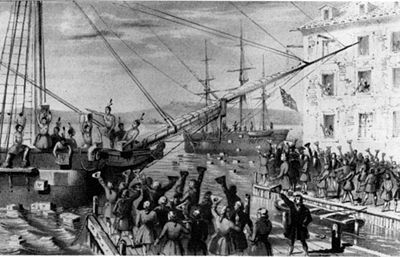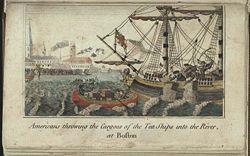Difference between revisions of "Boston Tea Party" - New World Encyclopedia
Laura Brooks (talk | contribs) |
Laura Brooks (talk | contribs) (→Event) |
||
| Line 5: | Line 5: | ||
==Background== | ==Background== | ||
| − | The [[Stamp Act 1765|Stamp Act of 1765]] and the [[Townshend Acts]] of 1767 angered colonists regarding British decisions on | + | The [[Stamp Act 1765|Stamp Act of 1765]] and the [[Townshend Acts]] of 1767 angered colonists regarding British decisions on taxing the colonies despite a lack of representation in the Westminster Parliament. One of the protesters was [[John Hancock]]. In 1768, Hancock's ship ''Liberty'' was seized by customs officials, and he was charged with smuggling. He was defended by [[John Adams]], and the charges were eventually dropped. However, Hancock later faced several hundred more indictments. |
| − | Hancock organized a | + | Hancock organized a boycott of tea from [[China]] sold by the [[British East India Company]], whose sales in the colonies then fell from 320,000 pounds (145,000 kg) to 520 pounds (240 kg). By 1773, the company had large debts, huge stocks of tea in its warehouses and no prospect of selling it because smugglers such as Hancock were importing tea without paying import taxes. The British government passed the [[Tea Act]], which allowed the East India Company to sell tea to the colonies directly, thereby allowing them to sell for lower prices than those offered by the colonial merchants and smugglers. |
| − | There were protests in both Philadelphia and New York, but it was those in Boston that made its mark in history. Still reeling from the | + | There were protests in both [[Philadelphia]] and [[New York]], but it was those in Boston that made its mark in history. Still reeling from the Hutchinson letters, Bostonians suspected the new Tea Tax was simply another attempt by the British Parliament to quash American freedom. [[Samuel Adams]], and others of like mind, called for agents and consignees of the [[East India Company]] tea to abandoned their positions; consignees who hesitated had their warehouses, and even their homes, attacked. |
| − | The first of many ships carrying the East India Company tea was the HMS <i>Dartmouth</i> arriving in late November 1765. A standoff ensued between the port authorities and the [[Sons of Liberty]]. Samuel Adams whipped up the growing crowd by demanding a series of protest meetings. Coming from both the city and outlying areas, thousands attended these meetings; every meeting larger than the one before. | + | The first of many ships carrying the East India Company tea was the HMS <i>Dartmouth</i> arriving in late November 1765. A standoff ensued between the port authorities and the [[Sons of Liberty]]. Samuel Adams whipped up the growing crowd by demanding a series of protest meetings. Coming from both the city and outlying areas, thousands attended these meetings; every meeting larger than the one before. The crowds shouted defiance not only at the British Parliament, the East India Company, and the HMS <i>Dartmouth</i> but at Governor [[Thomas Hutchinson]] as well, who was still struggling to have the tea landed. On the night of December 16 the protest meeting, held at Boston's Old South Church, was the largest yet seen. An estimated 8,000 people were said to have attended. |
==Event== | ==Event== | ||
[[Image:Boston Tea Party-Cooper.jpg|thumb|250px|1789 engraving]] | [[Image:Boston Tea Party-Cooper.jpg|thumb|250px|1789 engraving]] | ||
| − | On Thursday, | + | On Thursday, December 16, 1773, the evening before the [[tea]] was due to be landed, on a signal given by [[Samuel Adams]], the [[Sons of Liberty]] thinly disguised as [[Mohawk nation|Mohawk]] Indians, left the massive protest meeting and headed toward Griffin's Wharf, where lay the HMS <i>Dartmouth</i> and her newly arrived, tea bearing, sister ships the HMS <i>Beaver</i> and the HMS <i>Eleanour</i>. Swiftly and efficiently casks of tea where brought up from the hold to the deck, reasonable proof that some of the "indians" were, in fact, longshoremen. The cask were opened and the tea dumped overboard; the work, lasting well into the night, was quick, thorough, and efficient. By dawn 90,000 lbs (45 tons) of tea worth an estimated £10,000 had been consigned to waters of Boston harbor. Nothing else had been damaged or stolen, except a single padlock accidentally broken and anonymously replaced not long thereafter. Tea washed up on the shores around Boston for weeks. |
==Reaction== | ==Reaction== | ||
| Line 26: | Line 26: | ||
==External links== | ==External links== | ||
| − | |||
| − | |||
| − | |||
| + | *[http://www.boston-tea-party.org/what-chaused.html "What caused the Boston Tea Party?"] ''Boston Tea Party Historical Society"", observed March 8, 2007. | ||
| + | *[http://www.historyplace.com/unitedstates/revolution/teaparty.htm "Eyewitness Account of the Event"] ''The History Place'', observed March 8, 2007. | ||
| + | |||
| + | |||
[[Category:History and biography]] | [[Category:History and biography]] | ||
[[Category:American Revolution]] | [[Category:American Revolution]] | ||
Revision as of 20:56, 8 March 2007
The Boston Tea Party was a protest by the American colonists against Great Britain in which they destroyed many crates of tea bricks on ships in Boston Harbor.The English government was still in debt from the war with France and wanted the colonists to help pay for it. England raised taxes in America to recoup some of there losses. One of the taxes that England raised was on tea imported into the American Colonies. The incident, which took place on Thursday, December 16, 1773, has been seen as helping to spark the American Revolution.
Background
The Stamp Act of 1765 and the Townshend Acts of 1767 angered colonists regarding British decisions on taxing the colonies despite a lack of representation in the Westminster Parliament. One of the protesters was John Hancock. In 1768, Hancock's ship Liberty was seized by customs officials, and he was charged with smuggling. He was defended by John Adams, and the charges were eventually dropped. However, Hancock later faced several hundred more indictments.
Hancock organized a boycott of tea from China sold by the British East India Company, whose sales in the colonies then fell from 320,000 pounds (145,000 kg) to 520 pounds (240 kg). By 1773, the company had large debts, huge stocks of tea in its warehouses and no prospect of selling it because smugglers such as Hancock were importing tea without paying import taxes. The British government passed the Tea Act, which allowed the East India Company to sell tea to the colonies directly, thereby allowing them to sell for lower prices than those offered by the colonial merchants and smugglers.
There were protests in both Philadelphia and New York, but it was those in Boston that made its mark in history. Still reeling from the Hutchinson letters, Bostonians suspected the new Tea Tax was simply another attempt by the British Parliament to quash American freedom. Samuel Adams, and others of like mind, called for agents and consignees of the East India Company tea to abandoned their positions; consignees who hesitated had their warehouses, and even their homes, attacked.
The first of many ships carrying the East India Company tea was the HMS Dartmouth arriving in late November 1765. A standoff ensued between the port authorities and the Sons of Liberty. Samuel Adams whipped up the growing crowd by demanding a series of protest meetings. Coming from both the city and outlying areas, thousands attended these meetings; every meeting larger than the one before. The crowds shouted defiance not only at the British Parliament, the East India Company, and the HMS Dartmouth but at Governor Thomas Hutchinson as well, who was still struggling to have the tea landed. On the night of December 16 the protest meeting, held at Boston's Old South Church, was the largest yet seen. An estimated 8,000 people were said to have attended.
Event
On Thursday, December 16, 1773, the evening before the tea was due to be landed, on a signal given by Samuel Adams, the Sons of Liberty thinly disguised as Mohawk Indians, left the massive protest meeting and headed toward Griffin's Wharf, where lay the HMS Dartmouth and her newly arrived, tea bearing, sister ships the HMS Beaver and the HMS Eleanour. Swiftly and efficiently casks of tea where brought up from the hold to the deck, reasonable proof that some of the "indians" were, in fact, longshoremen. The cask were opened and the tea dumped overboard; the work, lasting well into the night, was quick, thorough, and efficient. By dawn 90,000 lbs (45 tons) of tea worth an estimated £10,000 had been consigned to waters of Boston harbor. Nothing else had been damaged or stolen, except a single padlock accidentally broken and anonymously replaced not long thereafter. Tea washed up on the shores around Boston for weeks.
Reaction
This act brought criticism from both colonial and British officials. For instance, Benjamin Franklin stated that the destroyed tea must be repaid, and he offered to repay with his own money. The British government responded by closing the port of Boston and put in place other laws that were known as the "Intolerable Acts," also called the Coercive Acts, or Punitive Acts. However, a number of colonists were inspired to carry out similar acts, such as the burning of the Peggy Stewart. The Boston Tea Party eventually proved to be one of the many causes that led to the American Revolution. At the very least, the Boston Tea Party and the reaction that followed served to rally support for revolutionaries in the thirteen colonies who were eventually successful in their fight for independence.
As far as tea drinking itself was concerned, many colonists, in Boston and elsewhere in the country, pledged to keep away from the drink as a protest, turning instead to "Balsamic hyperion" (made from raspberry leaves) and other herbal infusions. This social protest movement away from tea drinking was not, however, long-lived.
International influence
The Boston Tea Party is known around the world and has been inspirational to other rebels. For example, Erik H. Erikson records in his book "Gandhi's Truths" that when Mahatma Gandhi met with the British viceroy in 1930 after the Indian salt protest campaign, Gandhi took some duty-free salt from his shawl and said, with a smile, that the salt was "to remind us of the famous Boston Tea Party."
External links
- "What caused the Boston Tea Party?" Boston Tea Party Historical Society"", observed March 8, 2007.
- "Eyewitness Account of the Event" The History Place, observed March 8, 2007.
Credits
New World Encyclopedia writers and editors rewrote and completed the Wikipedia article in accordance with New World Encyclopedia standards. This article abides by terms of the Creative Commons CC-by-sa 3.0 License (CC-by-sa), which may be used and disseminated with proper attribution. Credit is due under the terms of this license that can reference both the New World Encyclopedia contributors and the selfless volunteer contributors of the Wikimedia Foundation. To cite this article click here for a list of acceptable citing formats.The history of earlier contributions by wikipedians is accessible to researchers here:
The history of this article since it was imported to New World Encyclopedia:
Note: Some restrictions may apply to use of individual images which are separately licensed.

